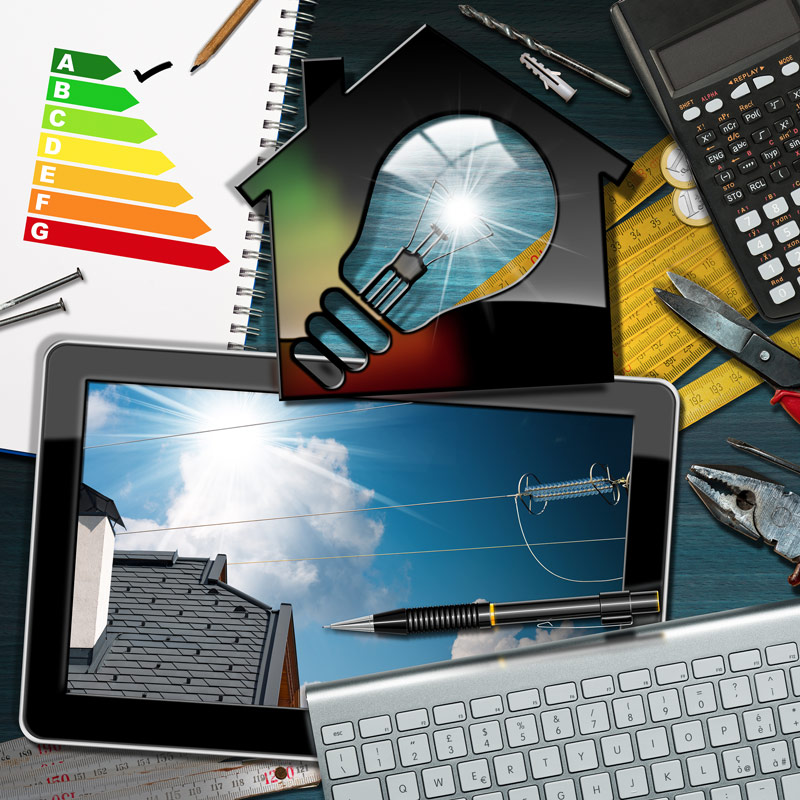 Energy Efficiency Engineering
Energy Efficiency Engineering
Comprehensive Energy Audits
The engineers at ERI have performed hundreds of energy audits for all types and sizes of facilities. We specialize in assessments of medium to large office buildings and take pride in helping our clients identify and implement cost effective energy solutions.
Obtaining a professionally performed energy audit is the crucial first step to a holistic approach of cost management for the operation of building, campus, or facility. Energy Resources Integration performs comprehensive energy audits which are tailored to each customer’s needs.
Each energy audit begins with a discussion to assess the owner’s and/or manager’s needs, and a conversation to understand the facility’s operation and identify any crucial areas. Then a detailed technical evaluation of the site and its energy consuming equipment is performed. After a discussion with key stakeholders of the potential no-cost, low-cost, and capital-intensive energy conservation measures, ERI professionals develop an audit report with a detailed description of the recommendations and their evaluation.

The focus is centered upon several key objectives
- Reducing the energy spend
- Improving the building performance
- Mitigating the carbon footprint
- Identifying operational and maintenance enhancements
- Improving tenant satisfaction and productivity
Retro-Commissioning
— Lawrence Berkeley National Laboratory
Retro-Commissioning for the Future
Retro-commissioning (RCx) is the process of identifying and implementing smart strategies and improvements to operations and maintenance systems for forecasting and real-time optimization of your building’s future energy performance.
RCx Achieves Savings
RCx can unlock your building’s energy potential by bringing systems and controls up to (or beyond) their intended level of performance. By performing RCx, we will help you achieve energy savings and reduce your operations costs. Whole-building RCx can achieve savings of 10% to 20% and more if the building has never been commissioned or has not been retro-commissioned in several years.
Cost-Effective Energy Results You Desire
Our philosophy is that sustainability and decarbonization can be cost-effectively achieved. More importantly, we listen to you. We don’t have predetermined solutions in mind when starting a project. When you work with Energy Resources Integration (ERI), you get a results-oriented energy engineering firm focused on the low-cost energy savings strategies that you desire. ERI has the deep experience needed to identify and analyze ways to utilize your building’s existing equipment and controls to improve performance. We strive to unlock energy savings in an economical manner by implementing low-cost improvements as they are identified, always structuring upgrade schedules to maximize utility incentives.
 Additional Benefits of Retro-Commissioning
Additional Benefits of Retro-Commissioning
- Decarbonization
- Improved safety
- Enhanced equipment reliability
- Increased worker productivity
- Improved occupant comfort
- Increased property values
- Reduced maintenance costs
- Improved indoor air quality
 Energy Efficiency Measures Investigated
Energy Efficiency Measures Investigated
- Chilled Water Reset
- Supply Air Temp Reset
- Economizer Optimization
- Optimum Start/Stop
- Duct Static Pressure Reset
- Nighttime Setbacks
- Existing VFD operations optimization
- Pumping Systems Optimization & VFDs
- Dampers, linkages, & sensors optimization • Lighting Controls Improvements
- VAV boxes assessment
- Hot water setpoints optimization
- Airflow Optimization
- Data Center Virtualization & Consolidation
- Continuous Commissioning
The ERI Team
The ERI team’s expertise in energy studies and retro-commissioning encompasses thousands of facilities and decades of experience. Our energy experts specialize in a broad range of clients including data centers, labs, and process facilities. We have been one of PG&E’s trusted RCx providers since 2012. Our expertise includes energy efficiency engineering and high-level energy management support to identify, model, and analyze projects that reduce our clients’ electricity and natural gas consumption with the goals of saving money and reducing greenhouse gases.
What Does a Retro-Commissioning Study Include?
From planning to hand-off, ERI is with you throughout the entire RCx process. Each phase in our process involves close contact with facility staff to prioritize efforts and maximize utility incentives.
-
Planning Phase
- Perform Energy Usage Analysis
- Set objectives and creating support from lead agency or business unit
- Perform site walkthrough
- Develop your RCx plan
- Project kickoff meeting
-
Investigation Phase
- Review facility documentation
- Perform diagnostic monitoring
- Perform functional tests
- Prioritize and select operational improvements
- Building or Process Modeling
- Simulation of proposed RCx measures
- Project cost estimation
- Detailed Reports describing the building, analyses performed, and recommendations
-
Implementation Phase
- Develop RCx implementation plan
- Implement desired operational improvements
- Implementation support; advising controls contractor to ensure savings are realized
-
Verification and Hand-Off Phase
- Savings verification / M&V
- Develop persistence plan
- Deliver final verification report
- Update systems manual
- Train your staff
- Close-out meeting
- Implement persistence strategies
Targeted Energy Assessments

Obtaining a professionally performed targeted energy audit is the first step to determine the benefits, costs, trade-offs, and impact of an already identified improvement. Energy Resources Integration performs targeted energy audits, incorporating measurement and verification as necessary, which are tailored to each customer’s needs and specific goals:
- Technology feasibility evaluation
- Side-by-side equipment performance comparison
- Life cycle cost analysis
- Operational enhancements and controls changes

ERI conducts focused assessments on specific equipment and processes. Our team will identify optimization strategies for existing equipment configurations or provide a comprehensive action plan to upgrade components for energy efficient operation. Some examples include:
- Chilled water systems
- Boilers, hot water, and steam systems
- Pumping systems
- Compressed air systems
- Refrigeration systems
- Fans and blowers
- Lighting

Building Energy Modeling
Building energy modeling provides a visual representation of building energy consumption to identify where, when, and how much energy is being used. Energy usage is broken down and quantified, allowing for extensive analysis of conservation opportunities. Energy efficiency measures can be modeled individually or comprehensively, allowing for customized projections of energy savings. Any proposed retrofits or controls modifications are analyzed to weigh the costs and benefits of such modifications.
The engineers at ERI have extensive experience with whole-building energy modeling for both retrofit and new construction projects. ERI staff work daily with building codes and bring this knowledge of design procedures to the design team. ERI has modeled a wide range of energy consuming systems including building envelope, HVAC, controls, lighting, motors, variable speed drives, transformers, insulation, windows and other building systems. All energy models are calibrated within 3% of the historical energy use for the building to ensure accuracy in the model. In addition, ERI ensures that all energy models are subject to an internal peer quality control review to allow for a consistent and thorough approach. After a baseline is established, the model is used to investigate various energy efficiency measures (lighting upgrades, HVAC retrofits, controls, building envelope, etc.) and cost effectiveness of projects is thoroughly evaluated.
Building owners and designers benefit from energy modeling by understanding the options available for optimizing building design to achieve energy savings and carbon reduction. The information provided by accurate energy modeling assists decision makers with a strategic energy reduction approach to pursue investments that have the greatest impact.
Strategic Energy Management
Strategic Energy Management creates a culture of continuous energy improvement. This starts with company goals and management support, and is ultimately achieved by staff members as part of an energy team. Improvements are realized in various forms, from productivity to operational improvements across commercial and industrial facilities.
- Data collection to obtain information needed to drive decision-making
- Education & Training through workshops, activities, and hands-on projects
- Measurement & Verification to quantify progress and confirm savings
- Build upon achievements for continuous improvement

Successful implementation of SEM is hinged upon empowering participants, driving change, and rewarding results.
ERI utilizes a dynamic workshop model with guest coaches, industry representatives, and subject matter expert speakers, to provide individual support for site activities. The ERI team consists of SEM experts (CP EnMS), M&V specialists (CMVP), industrial energy engineers (PE, CEM, DOE certifications), EM&V advisors, and education professionals.
ERI’s strategy includes key elements from Lean Six Sigma, such as the define, measure, analyze, improve, and control (DMAIC) approach, thus breaking complex problems down into simpler questions and forming steps to achieve progress. By integrating components of Lean Six Sigma with ISO 50001, change management techniques are coupled with energy coaching to emphasize energy and cost savings results.

The philosophy behind ERI’s SEM implementation model is:
Make it simple:
From workshop locations to the collection of data, the ERI team makes it simple for participants. This means that they do not have to figure the technical details out on their own.
Make it engaging:
ERI will provide a forum for them to discuss their ideas, questions, and challenges amongst their peers. Facilitation of this conversation is critical and will be achieved through various group activities, games, and collaborative assignments.
Provide the tools:
The tools are provided in the form of valuable information from guest speakers,
learning materials, excel-based tools, and data collection / measurement tools.
Hold team members accountable:
The energy team is expected to make use of the resources provided, convert plans to action, and achieve savings targets. Regular one on one check-ins help to keep things on track: individual coaching provides added motivation, identifies areas for improvement, and highlights successes to build upon.
